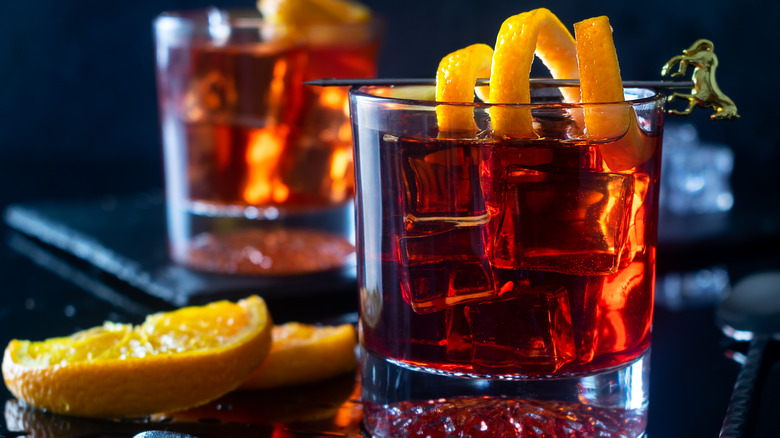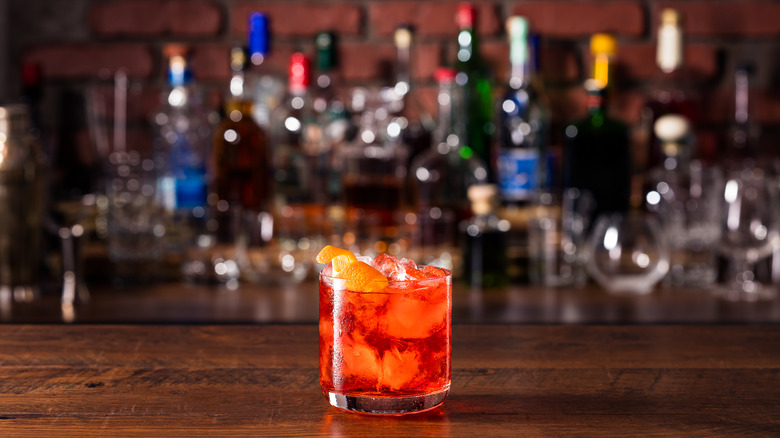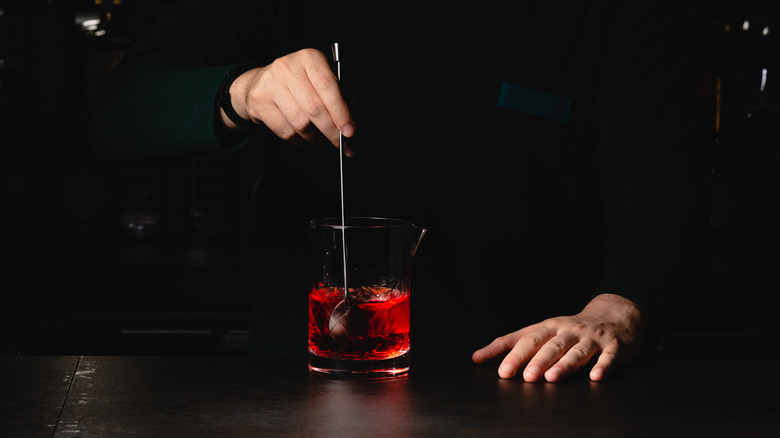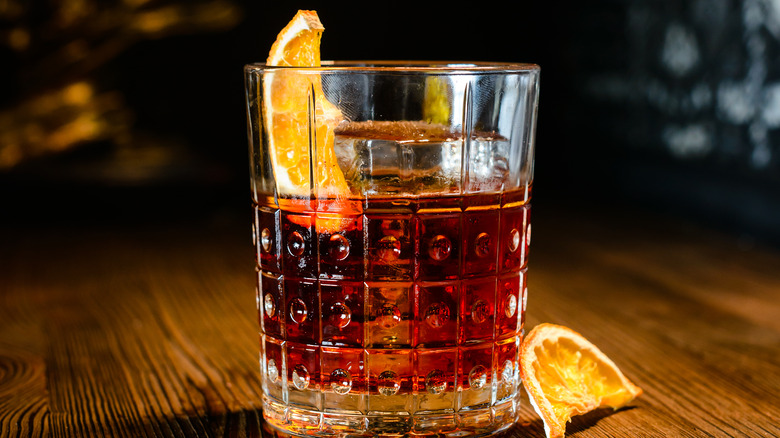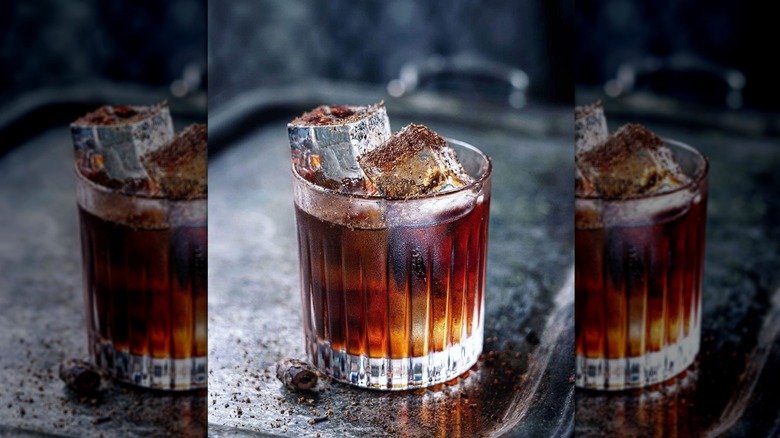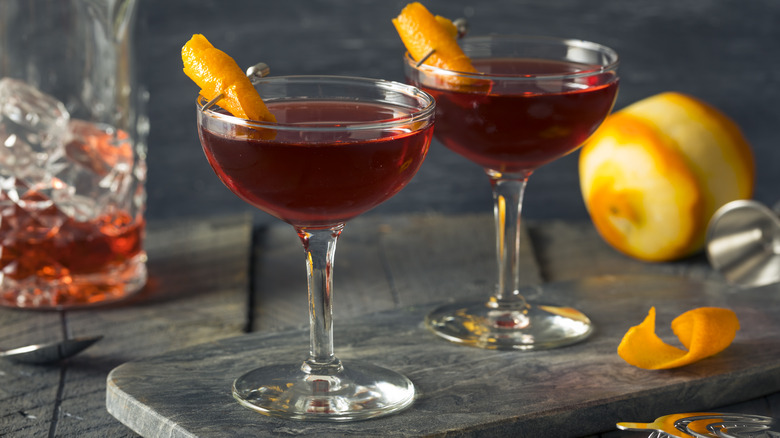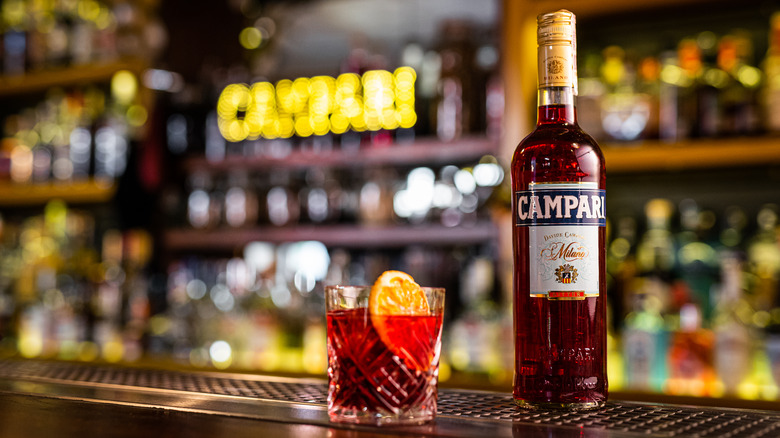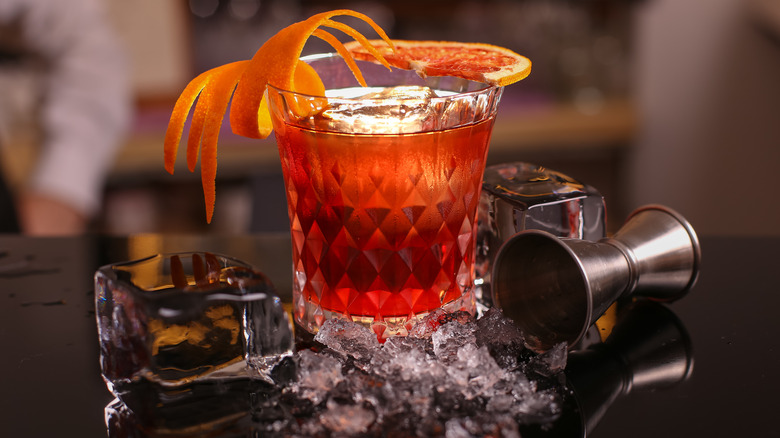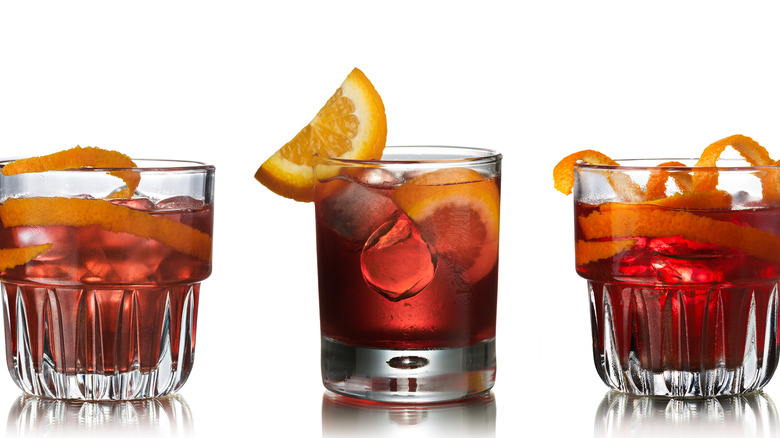What Is A Negroni And What Does It Taste Like?
It's bright red, comes in a simple drinking glass, and is certainly anything but bland. James Bond enjoyed one when he wasn't feeling his trademark martini, and Orson Welles was also a fan, reflecting that "the bitters are excellent for your liver, the gin is bad for you. They balance each other" (via Difford's Guide). It's none other than the fabulous and sophisticated Negroni, a drink that exudes coolness and chic simplicity.
It's a favorite for bartenders, too, with only three ingredients, and it has come in second place for the past six years in Drinks International's list of The World's Best-Selling Classic Cocktails. In the case of the Negroni, being consistently second implies nothing of its quality and everything of its elusive character. While the drink is delicious and quenches many a thirst for a strong cocktail, it is also intense in flavor and may take a few sips to get used to. (Tip: Take it slow or you'll be under the table in no time.) There's so many good reasons to start getting acquainted with the classic Negroni.
What is a Negroni?
Before we dive into the variations and the history of this iconic cocktail, a focus on its components can shed some light on its popularity. Most importantly, simplicity and quality ingredients are at the heart of the Negroni. It requires only three spirits in equal parts, which raises the alcohol level considerably, approximately 24% ABV according to Lyres. In its recipe, Liquor.com lists the ingredients as one ounce each of gin, Campari, and sweet vermouth, and an orange peel for garnish. With such a simple ingredient list, it's also essential to choose proper spirits because you will definitely be tasting the liquor.
Decanter recommends choosing a London Dry gin with a noticeable botanical composition for herbal qualities that stand out. The sweet vermouth will also balance the bitter and herbal characteristics of the gin and Campari. Vermouth is a wine-based spirit that has been fortified and left to sit with a variety of botanicals, herbs, and spices, which add depth and flavor (via Vinepair).
For the Negroni, a red vermouth is the best match for the added Campari, and Italian vermouths such as Cocchi or Cinzano are suitable options, notes Thrillist. If you've never tried vermouth by itself before, it's worth experimenting with different styles. Finally, the feature ingredient is the Campari, a bittersweet vibrant red liqueur with a top secret recipe, incorporating dozens of botanicals.
Once it's all stirred together, to serve the Negroni, Difford's Guide states that the classic garnish is an orange peel twist although a wedge works, too.
How do you make a Negroni cocktail?
Besides only needing a few easy-to-find ingredients, a Negroni requires no fancy mixology equipment. You'll just need an old fashioned glass, some ice, and something to stir it. Be sure not to forget about the ice — Delicious explains that it assists in the release of botanical aromas while diluting the drink ever so slightly. A Negroni still brings plenty of punch, so it's definitely not being watered down.
To make, add ice to your glass, and then pour in the equal parts gin, sweet vermouth, and Campari — and stir. This last step is another point of contention for die-hard classicists. You will surely find a bartender that vigorously shakes a Negroni; however, many experts say the motion is too strong and will not benefit the botanical notes of the drink. By giving the liquors a simple stir, the aromas are released and can subtly mingle together, notes Delicious. Serve with a twist of orange peel on the side of the glass to further bring out the citrus notes in the Campari.
Also, the simple, three-ingredient list actually lends itself very well to making a large batch of Negronis for get-togethers, as recommended by Saveur. Just be sure to give the drink a quick stir once it's on ice.
Just enjoy with caution as a Negroni is notoriously strong. The late Anthony Bourdain once wrote in Maxim about an evening in Tuscany when he had four to five of the cocktails leading to a "Negroni-related incident" involving cheese. We'll leave the details at that.
What does a Negroni taste like?
If you've tried gin, sweet vermouth, and Campari individually, then you might have an inkling of the combined flavors in this cocktail. Red Online describes the beauty of a Negroni as being the perfect balance of bitter, sweet, fruity, and herbal flavors. Campari has plenty of citrus notes amidst its dozens of ingredients, as well as bitter flavors that blend smoothly with the gin.
The combination of flavors in this drink works well with snack foods, as HuffPost explains that the bitters in the Campari are known to open up the appetite. The site explains that the bitters enhance digestion and promote the secretion of digestive juices, which makes the Negroni a fantastic pre-dinner or aperitif drink to get your evening started. If you're having more than one, definitely make sure to eat some canapés or have a bag of chips handy to counterbalance the alcohol, or else you might not make it to dinner.
If you're tired of sickly sweet or sour cocktails, a Negroni brings on a whole other level and depth of flavor that adapts well to any time of the year. The Cocktails For You blog remarks how the bright citrus flavors make a Negroni refreshing in the summer, while the herbaceous bitter notes are warming for the cooler months.
What is the nutritional value of a traditional Negroni?
While it would seem that a drink with only a few ingredients couldn't be that high calorically, you might be surprised to learn the truth about the Negroni. The combination of one-ounce gin, one-ounce Campari, one-ounce sweet vermouth, and an orange peel that makes up a standard Negroni cocktail actually contains 193 calories. One drink also contains 14 grams of carbohydrates and four milligrams of sodium. You won't be getting any protein, but you will be getting some nutritional benefits in its three milligrams of calcium, three milligrams of magnesium, and 33 milligrams of potassium. It's a fairly sweet drink, though, and it also contains 22% of your daily value of sugar, with 11 grams per serving.
For those who either want to cut down on the calories or just make the Negroni last longer, you could use less of each of the liqueurs and instead make a Negroni Swizzle by adding club soda to make up the lost volume. Another popular variation is the Negroni Fizz, which is topped off with tonic water, wine, or even Prosecco.
What came before the Negroni?
For such a simple cocktail, the Negroni sure has its fair share of origin stories. The most widely accepted tale is also the most anecdotal, making it tricky to know what exactly happened 100-plus years ago when the classic drink was said to have been invented. Prior to written records of its name in 1950s-era UK and US publications, multiple other cocktails with overlapping ingredients were often detailed in writing, according to Difford's Guide.
The website mentions various examples such as the Dundorago, published in a book of American cocktails in 1895, which called for gin, vermouth, and Calisaya bitters that contain quinine (also present in Campari). In 1927, the Boulevardier cocktail was first noted, substituting the gin for bourbon for a weightier drink, explains Serious Eats.
Gin, sweet vermouth, and Campari cocktails were also enjoyed by the French and the Spanish in the 1940s, notes Difford's Guide. Even earlier, the website describes the Campari Mixte from a French cocktail book published in 1929, which calls for equal parts gin, sweet vermouth, and Campari. Not to mention the Camparinete, instituting equal parts of the three liquors, that was published in 1934 (via Elemental Mixology).
Suffice to say that anecdotal accounts of the drink being created by a single person — assumed by many to be an Italian by the name of Count Camillo Negroni in 1919 — have some competition. With such balanced ingredients and flavor, it's no wonder a variation of the Negroni was being made in some form or another over the past century and a half.
The history of the Negroni
In many renditions of the Negroni creation story, Difford's Guide notes that Count Camillo Negroni — an Italian cowboy who had spent some time in the United States — was responsible for the creation of the drink. The site shares the story of this fateful moment in 1919, when the Count asked a bartender at a Florentine bar to prepare an Americano with gin instead of soda water for an extra kick. An Americano, also known as a Milano-Torino for the cities of origin of its ingredients, is equal parts Campari and sweet vermouth, with soda water.
The story goes that the new variation was quite good and increasingly requested by other bar goers, ultimately being named the Negroni. As a result of its popularity, the Negroni family opened a distillery the same year, producing the ready mixed cocktail in bottles, notes Food & Wine.
While this is more often the recounted story, members of the Negroni family have since denied the existence of a Camillo in their lineage, according to Difford's Guide. The alternate origin story places the first Negroni in Senegal around 1860 when Count Pascal Oliver de Negroni was posted there during a war and prepared the beverage as a gift for his bride (via Drinking Cup). Campari was only invented in 1860 so whether the beverage speedily made its way to Africa, or Pascal's version of the cocktail had used another bitter, is truly unknown (via Cocktails For You).
How many versions of a Negroni exist?
There are likely infinite variations of the classic Negroni because creative license in the cocktail world has no limits. However, multiple sources such as Delicious have specified that a Negroni requires Campari as one of the components to be considered worthy of the drink title — and we agree. It's also the liqueur that gives a Negroni its vibrant color and it would be a shame to remove that element.
Nevertheless, many versions of the Negroni are made without Campari, as it can be an acquired taste. Although it is certainly bitter, the liqueur is balanced by sufficient sweetness to make it incredibly palatable. If you're hesitant about the bitterness, you can start with a smaller quantity of Campari and work your way up. Alternatively, Aperol, an aperitif similar to Campari, is definitely a lighter and sweeter option.
The Negroni Sbagliato deviates from the classic with its own quirky tale. Food & Wine tells the story of a bartender in Milan in the late '60s who accidentally reached for Prosecco instead of gin, adding a sparkle to the drink. Hence the name sbagliato which translates in Italian as "mistaken." Another rendition of the Negroni that diverges from its bright red look is the White Negroni. Food & Wine describes how the sweet vermouth and Campari are replaced with Lillete Blanc and Suze, both aperitif liqueurs.
For a version that tones down the botanical notes, a Negrosky replaces the gin with vodka according to Fine Dining Lovers. In addition to mezcal, tequila, and bourbon, the gin substitutions are endless — and so are the ways to customize this drink.
There's a Negroni Week
Because of the heightened interest in artisanal gin, vermouth, and bitters over the past decade or so, Conde Nast Traveler suggests it's in part responsible for the increased popularity of the Negroni cocktail. In 2013, this led to Negroni Week, a seven-day fundraising and drinking event every September planned by Imbibe Magazine in partnership with Campari. Presently, the organization indicates that 12,000 venues worldwide participate in the event, sharing in the love for Negronis while raising money for charities (approximately $3 million to date!)
Besides raising money for charity and spreading the cocktail to those that have not yet acquired the taste for it, most venues invent their own variations on the drink for the event. The Negroni Week site lists dozens of wildly creative recipes including frozen Negronis, others with coffee or fruit liqueurs, a sour take on the drink, and even smoky additions. Consumers are also welcome to send in their drink ideas to add to the list of never-ending varieties.
